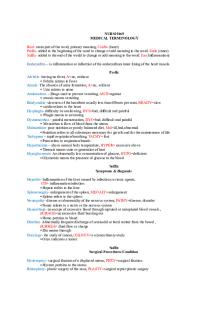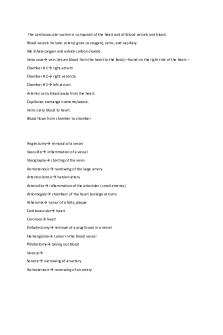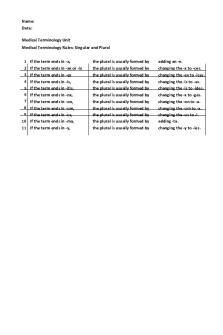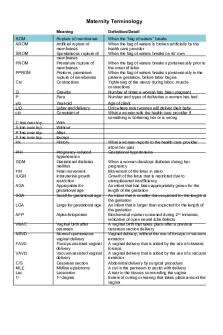HSM544 Medical Terminology OF Cardiovascular System PDF

| Title | HSM544 Medical Terminology OF Cardiovascular System |
|---|---|
| Course | Medical Instrumentation |
| Institution | Universiti Teknologi MARA |
| Pages | 9 |
| File Size | 266.2 KB |
| File Type | |
| Total Downloads | 52 |
| Total Views | 146 |
Summary
dictionary or notes regarding medical terminology. about cardiovascular system and skeleton system. hope this will helps. thankk you...
Description
MEDICAL TERMINOLOGY OF CARDIOVASCULAR SYSTEM GROUP CORONARY ARTERY DISEASE (CAD) ATHEROSCLEROSIS
ISCHEMIA ANGINA
MYOCARDIAL INFARCTION HEART FAILURE
CARDITIS
PATHOLOGY Coronary artery disease ( atherosclerosis of the coronary arteries that reduces the blood supply to the heart muscle) Atherosclerosis (hardening and narrowing of the arteries caused by a buildup of cholesterol plaque on the interior walls of the arteries)
WORDS coronary heart disease (CHD) ischemic heart disease ather/o means plaque or fatty substance, and -sclerosis means abnormal hardening ather means plaque -oma means tumor isch means to hold back -emia means blood angina pectoris
atheroma ( a characteristic of atherosclerosis, is a deposit of plaque on or within the arterial wall) Ischemia (a condition in which there is an insufficient supply of oxygen in the tissues due to restricted blood flow to a part of the body ) Angina ( a condition in which severe episodes of chest pain occur due to an inadequate blood flow to the myocardium) Stable angina (occurs during exertion (exercise) and resolves with rest.) Unstable angina (may occur either during exertion or rest and is a precursor to a myocardial infarction) myocardial infarction (the occlusion (blockage) of one or more coronary arteries caused by plaque buildup.) Heart failure ( occurs most commonly in the elderly, often after the heart has congestive heart failure (CHF) been weakened or damaged by other health issues) Left-sided heart failure (causes an accumulation of fluid in the lungs also known as pulmonary edema . This occurs because the left side of the heart, which is its main pumping chamber, is unable to efficiently pump oxygen-rich blood from the lungs to the rest of the body) Right-sided heart failure ( often the result of left-sided heart failure, causes fluid buildup throughout the rest of the body. This occurs because the right side of the heart is unable to efficiently pump blood throughout the rest of the body.) Cardiomegaly (the abnormal enlargement of the heart that is frequently cardi/o means heart -megaly means enlargement associated with heart failure as the heart enlarges in an effort to compensate for its decreased pumping ability ) Carditis (n inflammation of the heart) card means heart -itis means inflammation Endocarditis (an inflammation of the inner lining of the heart) endo- means within card means heart -itis means inflammation Bacterial endocarditis (an inflammation of the lining or valves of the heart caused by the presence of bacteria in the bloodstream.) Pericarditis ( an inflammation of the pericardium ) peri- means surrounding card means heart
Myocarditis (an inflammation of the myocardium )
Cardiomyopathy (the term used to describe all diseases of the heart muscle) Dilated cardiomyopathy ( a disease of the heart muscle that causes the heart to become enlarged and to pump less strongly. ) heart murmur (an abnormal blowing or clicking sound heard when listening to the heart or a neighboring large blood vessels) Valvulitis ( an inflammation of a heart valve)
MYOCARDIUM
HEART VALVES
Valvular prolapse (the abnormal protrusion of a heart valve that results in the inability of the valve to close completely )
CARDIAC ARREST & ARRHYTHMIA
Valvular stenosis (a condition in which there is narrowing, stiffening, thickening, or blockage of one or more valves of the heart.) Arrhythmia (the loss of the normal rhythm of the heartbeat. ) Asystole (the complete lack of electrical activity in the heart.)
Cardiac arrest (n event in which the heart abruptly stops beating or develops an arrhythmia that prevents it from pumping blood effectively) Sudden cardiac death (results when treatment of cardiac arrest is not provided within a few minutes.) Heart block (a congenital or acquired arrhythmia caused by the electrical signal moving through the heart being partially or completely blocked from reaching the ventricles) Bradycardia ( an abnormally slow resting heart rate)
Tachycardia (an abnormally rapid resting heart rate)
ATRIAL
&
-itis means inflammation my/o means muscle card means heart -itis means inflammation cardi/o means heart my/o means muscle -pathy means disease
valvul means valve -itis means inflammation valvul means valve -ar means pertaining to Prolapse means the falling or dropping down of an organ or internal part Stenosis is the abnormal narrowing of an opening
a- means without systole means contraction flat line
brady- means slow card means heart -ia means abnormal condition tachy- means rapid card means heart -ia means abnormal condition paroxysmal supraventricular tachycardia
Supraventricular tachycardia (n episode that begins and ends abruptly during which there are very rapid and regular heartbeats that originate at or above the atrioventricular (AV) node) Ventricular tachycardia ( a very rapid heartbeat that begins within the V-tach ventricles. ) Fibrillation ( a potentially life-threatening fast and irregular heartbeat, compared to the fast but regular rhythm of tachycardia.)
VENTRICULAR FIBRILLATIONS
BLOOD VESSEL ABNORMALITIES
THROMBOSES EMBOLISMS
&
Atrial fibrillation (he most common type of tachycardia. It occurs when the A-fib normal rhythmic contractions of the atria are replaced by rapid, uncontrolled twitching of the muscular heart wall.) Ventricular fibrillation (consists of rapid, irregular, and useless contractions of V-fib the ventricles) Palpitation (a pounding or racing heartbeat with or without irregularity in rhythm.) Vasculitis (the inflammation of a blood vessel) vascul means blood vessels -itis means inflammation Polyarteritis ( a form of vasculitis involving several medium and small arteries poly- means many at the same time) arter means artery -itis mean inflammation Temporal arteritis (a form of vasculitis that can cause headaches, visual giant cell arteritis impairment, jaw pain, and other symptoms.) Angiostenosis (the abnormal narrowing of a blood vessel ) angi/o means vessel -stenosis means abnormal narrowing Hemangioma (a benign tumor made up of newly formed blood vessels) hem means blood angi means blood or lymph vessel -oma means tumor Hypoperfusion (a deficiency of blood passing through an organ or body part) Perfusion is the flow of blood through the vessels of an organ. Aneurysm (a localized weak spot or balloon-like enlargement of the wall of an aortic aneurysm, abdominal aortic aneurysm, artery) and popliteal aneurysm. Arteriosclerosis (any of a group of diseases characterized by thickening and arteri/o means artery the loss of elasticity of arterial walls) -sclerosis mean abnormal hardening Arteriostenosis (the abnormal narrowing of an artery or arteries) arteri/o means artery -stenosis means abnormal narrowing Chronic venous insufficiency (a condition in which venous circulation is venous insufficiency inadequate due to partial vein blockage or to the leakage of venous valves.) Phlebitis (the inflammation of a vein) phleb means vein -itis means inflammation Varicose veins (abnormally swollen veins that usually occur in the superficial veins of the legs.) thrombosis (the abnormal condition of having a thrombus) thromb means clot -osis means abnormal condition or disease Thrombus ( a blood clot attached to the interior wall of an artery or vein ) thromb means clot -us is a singular noun ending thrombotic occlusion (the blocking of an artery by a thrombus) Thrombotic means caused by a
thrombus.
occlusion means blockage. coronary thrombosis ( damage to the heart muscle caused by a thrombus blocking a coronary artery )
Deep vein thrombosis (DVT) ( the condition of having a thrombus attached to the interior wall of a deep vein) Embolism (the sudden blockage of a blood vessel by an embolus )
BLOOD DISORDER
embolus ( a foreign object, such as a blood clot, a quantity of air or gas, or a bit of tissue or tumor, that is circulating in the blood) Peripheral vascular diseases (disorders of blood vessels that are located outside of the heart and brain) Peripheral arterial disease (an example of a peripheral vascular disease that is caused by atherosclerosis) Raynaud’s disease (a peripheral arterial occlusive disease in which intermittent attacks are triggered by cold or stress. ) Blood dyscrasia (any pathologic condition of the cellular elements of the blood ) Hemochromatosis (a genetic disorder in which the intestines absorb too much iron)
Leukopenia (a decrease in the number of disease-fighting white blood cells circulating in the blood ) Polycythemia (an abnormal increase in the number of red cells in the blood due to excess production of these cells by the bone marrow.) Sepsis (a potentially life-threatening infection that results from bacteria or other infectious organisms entering the bloodstream. ) Thrombocytopenia (a condition in which there is an abnormally small number of platelets circulating in the blood) Thrombocytosis (an abnormal increase in the number of platelets in the circulating blood) hemorrhage ( the loss of a large amount of blood in a short time ) Cholesterol (a fatty substance that travels through the blood and is found in all parts of the body.)
coron means crown -ary means pertaining to thromb means clot -osis means abnormal condition deep venous thrombosis
embol means something inserted -ism means condition embol means something inserted -us is a singular noun ending
dys- means bad, and -crasia means a mixture or blending hem/o means blood chromat means color -osis means abnormal condition or disease leuk/o means white -penia means deficiency
thromb/o means clot cyt/o means cell -penia means deficiency thromb/o means clot cyt means cell -osis means abnormal condition hem/o means blood -rrhage means bleeding
Hyperlipidemia (the general term used to describe elevated levels of cholesterol and other fatty substances in the blood) Myelodysplastic syndrome (a type of cancer in which there is insufficient production of one or more types of blood cells due to dysfunction of the bone marrow) Leukemia ( a type of cancer characterized by a progressive increase in the number of abnormal leukocytes (white blood cells) found in blood-forming tissues, other organs, and in the circulating blood Anemia ( a lower-than-normal number of erythrocytes (red blood cells) in the blood) Aplastic anemia ( an absence of all formed blood elements caused by the failure of blood cell production in the bone marrow) Iron-deficiency anemia ( the most common form of anemia. Iron, an essential component of hemoglobin, is normally obtained through food intake and by recycling iron from old red blood cells. ) Megaloblastic anemia ( a blood disorder characterized by anemia in which the red blood cells are larger than normal )
HYPERTENSION
HYPOTENSION
Pernicious anemia (caused by a lack of the protein intrinsic factor (IF) that helps the body absorb vitamin from the gastrointestinal tract) Hemolytic anemia (an inadequate number of circulating red blood cells due to the premature destruction of red blood cells by the spleen) Sickle cell anemia ( a serious genetic disorder that causes abnormal hemoglobin, resulting in some red blood cells assuming an abnormal sickle shape) Thalassemia ( an inherited blood disorder that causes mild or severe anemia due to reduced hemoglobin and fewer red blood cells than normal.) Hypertension (HTN) (the elevation of arterial blood pressure to a level that is likely to cause damage to the cardiovascular system) Essential hypertension @primary hypertension (consistently elevated blood pressure of unknown cause) Secondary hypertension (caused by a different medical problem, such as a kidney disorder or a tumor on the adrenal glands.) Malignant hypertension (characterized by very high blood pressure.) Hypotension (lower-than-normal arterial blood pressure. ) Orthostatic hypotension (low blood pressure that occurs upon standing up. )
hyper- means excessive lipid means fat -emia means blood condition leuk means white -emia means blood condition
an- means without or less than -emia means blood condition a- means without plast means growth -ic means pertaining to
megalo- means large blast means immature -ic means pertaining to
hem/o means relating to blood, and -lytic means to destroy
high blood pressure Idiopathic means a disease of unknown cause. The classifications of blood pressure for adults with this condition are summarized in
postural hypotension Orthostatic means relating to an upright or standing position.
DIAGNOSTIC PROCEDURE
Blood tests, computed tomography (CT) scans, MRIs, and ultrasonic diagnostic procedures Angiography - A radiographic (x-ray) study of the blood vessels after the injection of a contrast medium o angi/o means blood vessel o -graphy means the process of recording Cardiac catheterization - A diagnostic and treatment procedure in which a catheter is passed into a vein or artery and then guided into the heart Digital subtraction angiography (DSA) - uses angiography with computer assistance to clarify the view of the area of interest in the cardiovascular system by “subtracting” the soft tissue and bones from the images. Duplex ultrasound – A diagnostic procedure to image the structures of the blood vessels and the flow of blood through these vessels. Venography - radiographic test that provides an image of specific veins after a contrast dye is injected o phleb/o means vein o -graphy means the process of recording
ELECTROCARDIOGRAPHY
Electrocardiography - the noninvasive process of recording the electrical activity of the myocardium o electr/o means electric o cardi/o means heart o -graphy means the process of recording a picture or record electrocardiogram - a record of the electrical activity of the myocardium o electr/o means electric o cardi/o means heart o -gram means picture or record Holter monitor - A portable electrocardiograph that is worn by an ambulatory patient to continuously monitor the heart rates and rhythms over a 24- or 48-hour period. stress test - performed to assess cardiovascular health and function during and after stress. thallium stress test - performed to evaluate how well blood flows through the coronary arteries of the heart muscle during exercise by injecting a small amount of thallium into the bloodstream.
TREATMENT PROCEDURE GROUP ANTIHYPERTENSIVE
TREATMENT Antihypertensive ( a medication administered to lower blood pressure.) ACE inhibitor (blocks the action of the enzyme that causes the blood vessels to contract, resulting in hypertension.)
WORDS
beta-blocker (reduces the workload of the heart by slowing the rate of the heartbeat. ) Calcium channel blocker agents (cause the heart and blood vessels to relax by decreasing the movement of calcium into the cells of these structures. ) Diuretic (administered to stimulate the kidneys to increase the secretion of urine to rid the body of excess sodium and water.) Antiarrhythmic (a medication administered to control irregularities of the ADDITIONAL heartbeat) MEDICATION anticoagulant ( slows coagulation and prevents new clots from forming) Coagulation is the process of Coumadin® (is a brand name for warfarin, is an anticoagulant clotting blood. administered to prevent blood clots from forming or growing larger. ) Heparin (another common anticoagulant.) Aspirin ( may be recommended to reduce the risk of a heart attack or stroke by reducing the ability of the blood to clot.) Cholesterol-lowering drugs (used to combat hyperlipidemia by reducing the undesirable cholesterol levels in the blood.) Digitalis (available as the drug preparation digoxin, strengthens the contraction of the heart muscle, slows the heart rate, and helps eliminate fluid from body tissues. ) Thrombolytic ( dissolves or causes a thrombus to break up) thromb/o means clot -lytic means to destroy Tissue plasminogen activator (a thrombolytic that is administered to some patients having a heart attack or stroke. ) vasoconstrictor (causes blood vessels to narrow.) Vasodilator (causes blood vessels to expand.) Nitroglycerin ( a vasodilator that is prescribed to prevent or relieve the pain of angina by dilating the blood vessels to the heart. ) NUTRITIONAL INTERVENTION CARDIAC SURGERY angi/o means blood CLEARING BLOCKED Angioplasty (the technique of mechanically widening a narrowed or obstructed vessel ARTERIES AND blood vessel) -plasty means surgical VEINS repair Percutaneous transluminal coronary angioplasty (PTCA) - a procedure in balloon angioplasty which a small balloon on the end of a catheter is used to open a partially blocked coronary artery by flattening the plaque deposit and stretching the lumen Laser angioplasty ( involves a laser on the end of a catheter, which uses beams of light to remove the plaque deposit. ) stent (a wire-mesh tube that is commonly placed after the artery has been opened.) re- means again Restenosis ( the condition when an artery that has been opened by angioplasty closes again ) -stenosis means
atherectomy (the surgical removal of plaque buildup from the interior of an artery)
CORONORY ARTERY BYPASS GRAFF
CARDIAC ARREST & ARRHYTHMIAS
BLOOD, BLOOD VESSEL & BLEEDING
narrowing ather means plaque -ectomy means surgical removal
carotid endarterectomy (the surgical removal of the lining of a portion of a clogged carotid artery leading to the brain.) Coronary artery bypass graft (CABG) - requires opening the chest, a piece of vein from the leg or chest is implanted on the heart to replace a blocked coronary artery and to improve the flow of blood to the heart. minimally invasive coronary artery bypass (an alternative technique for some keyhole bypass or a buttonhole bypass bypass patients. ) Defibrillation (the use of electrical shock to restore the heart’s normal rhythm.) automated external defibrillator (AED) (use by nonprofessionals in emergency situations when defibrillation is required) artificial pacemaker (primarily as treatment for bradycardia or atrial fibrillation, although it is sometimes used to treat other heart conditions) implantable cardioverter-defibrillator (a double-action pacemaker.) Cardiac ablation (a procedure that uses radio-frequency energy (heat) or cryoablation (extreme cold) to scar or destroy the heart tissue triggering an abnormal heart rhythm.) Valvuloplasty (the surgical repair of a heart valve) valvul/o means valve -plasty means surgical repair Heart valve replacement (surgery to replace one of the heart’s four valves, usually the aortic or mitral valve) Transcatheter aortic valve replacement (TAVR) (a relatively new, minimally invasive procedure in which the existing valve is left in place. ) Cardiopulmonary resuscitation (an emergency procedure for life support CPR consisting of artificial respiration and manual external cardiac compression) Cardiopulmonary means pertaining to the heart and lungs. aneurysmectomy (the surgical removal of an aneurysm) aneurysm means aneurys -ectomy means surgical removal Aneurysmorrhaphy (the surgical suturing of an aneurysm) aneurysm/o means aneurysm -rrhaphy means surgical suturing Aneurysm clipping (surgical method to isolate an aneurysm from the rest of the circulatory system by placing a small clip across its neck.)
Arteriectomy (the surgical removal of part of an artery)
...
Similar Free PDFs

Medical Terminology
- 50 Pages

Medical Terminology
- 6 Pages

Medical Terminology
- 2 Pages

Medical Terminology
- 4 Pages

Cardiovascular system
- 2 Pages

Cardiovascular System
- 2 Pages

Cardiovascular System
- 12 Pages

Medical Terminology EXAM 2
- 4 Pages

Medical terminology Modules
- 158 Pages

Medical Terminology Terms
- 22 Pages

Medical Terminology-Plurals Quiz
- 3 Pages

Medical terminology 17
- 4 Pages

Med term - medical terminology
- 20 Pages
Popular Institutions
- Tinajero National High School - Annex
- Politeknik Caltex Riau
- Yokohama City University
- SGT University
- University of Al-Qadisiyah
- Divine Word College of Vigan
- Techniek College Rotterdam
- Universidade de Santiago
- Universiti Teknologi MARA Cawangan Johor Kampus Pasir Gudang
- Poltekkes Kemenkes Yogyakarta
- Baguio City National High School
- Colegio san marcos
- preparatoria uno
- Centro de Bachillerato Tecnológico Industrial y de Servicios No. 107
- Dalian Maritime University
- Quang Trung Secondary School
- Colegio Tecnológico en Informática
- Corporación Regional de Educación Superior
- Grupo CEDVA
- Dar Al Uloom University
- Centro de Estudios Preuniversitarios de la Universidad Nacional de Ingeniería
- 上智大学
- Aakash International School, Nuna Majara
- San Felipe Neri Catholic School
- Kang Chiao International School - New Taipei City
- Misamis Occidental National High School
- Institución Educativa Escuela Normal Juan Ladrilleros
- Kolehiyo ng Pantukan
- Batanes State College
- Instituto Continental
- Sekolah Menengah Kejuruan Kesehatan Kaltara (Tarakan)
- Colegio de La Inmaculada Concepcion - Cebu


